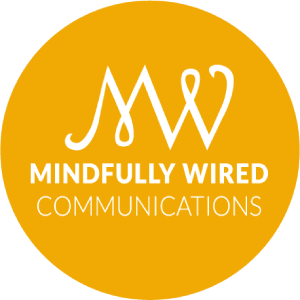“Let’s get it done” – Applying Coastal Futures’ 2023 mantra to science communication
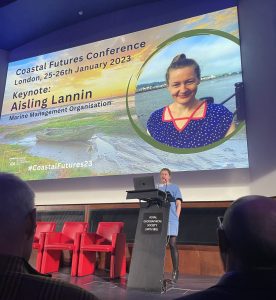 Our Creative Comms Officer, Joe Nutt, reflects on key themes and insights from the UK’s headline marine conservation conference: Coastal Futures.
Our Creative Comms Officer, Joe Nutt, reflects on key themes and insights from the UK’s headline marine conservation conference: Coastal Futures.
“We’ve just got to get on and do it,” says Aisling Lannin from the Marine Management Organisation (MMO) to a chorus of applause from right across the room at the second keynote address of Coastal Futures 2023. The UK’s headline marine conservation conference returned to in-person for its 30th anniversary after two years online during the COVID pandemic, with everyone who is anyone from the UK marine scene filing down the red carpet to fill the grand old rooms of the Royal Geographical Society. (Okay, so it wasn’t quite “red carpet,” but we did get name tags, which always make you feel a bit special!)
As I listened to the speakers that followed Aisling, it became clear that two years of on-and-off lockdowns had attendees itching to turn discussion into action, with a number of them following Aisling’s call for less chatter about what we can do to secure the health of our seas, and more focus on delivering impactful solutions.
A call to action
But if it was that easy, we’d already be well on our way to crossing things off the foot-long checklist of stuff we really need to get done in the coming decades, like implementing the 30×30 vision (no, not a new marketing campaign by Specsavers) of restoring ocean biodiversity, with the target of 30% of the UK’s coastal seas protected by 2030. Or, delivering initiatives to support coastal communities adversely affected by flooding and coastal erosion, and exacerbated by climate change.
So as I stood by the buffet in-between panel discussions, staring blankly at the shedload of chaotically arranged sandwiches in front of me, I thought to myself: “What is it that’s holding us back? Is it money?”… Well, yes, but what’s new there? “Is it technology?” Partly. But then it hit me, just as the patience of the hangry line of scientists queuing behind me was about to expire…
The problem is that it isn’t down to the 600 people at Coastal Futures – both physically and virtually – to make the decisions and changes needed to advance these science-based solutions. “Buy-in” from across all of society is significant here: it requires decision-makers following scientific advice in co-designing policy solutions, with contributions from stakeholders. It also needs businesses, NGOs and local communities to subscribe to these policies and to scientific advice, adapting their behaviours accordingly for the benefit of our natural environment.
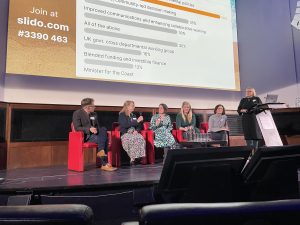 In both these cases, the only way of achieving real buy-in is through, yep, you guessed it: effective communication. And this can be hard – as one delegate put it, “Communication is one of the biggest challenges facing policy – getting everyone on the same page.” So if we need action, and action requires buy-in and momentum from society, and communication is the key…what does that look like? The truth is, there is no one-size-fits-all answer. In-depth understanding and a bespoke approach is central to generating the right action in the right way.
In both these cases, the only way of achieving real buy-in is through, yep, you guessed it: effective communication. And this can be hard – as one delegate put it, “Communication is one of the biggest challenges facing policy – getting everyone on the same page.” So if we need action, and action requires buy-in and momentum from society, and communication is the key…what does that look like? The truth is, there is no one-size-fits-all answer. In-depth understanding and a bespoke approach is central to generating the right action in the right way.
Sometimes, that ‘right way’ might just be hidden inside a fortune cookie of all places! POV: You’re the CEO of a major American seafood supplier and you’re concerned about unsustainable tuna fishing practices in the Western-Central Pacific (you’d be surprised about the number of people kept up at night by the same, really specific worry). The science says that adopting a harvest strategy is your best chance at securing the health of the area’s stocks. But the decision-makers – delegates at the Western-Central Pacific Fisheries Commission (WCPFC) – are putting their own political interests before the collective environmental good. How do you get them to change their mind?
The answer can be found in the mystical art of advocacy. We work with the Global Tuna Alliance (GTA), an independent association of seafood suppliers and retailers who use their collective purchasing power to influence decision-makers to reform the tuna fishing industry. At the most recent WCPFC meeting, we sent the GTA armed with GTA-branded fortune cookies that contained messages mixing old proverbs with the GTA’s asks. We also helped put on a side-event for delegates that featured a projection of quotes from GTA Partners playing on loop in the background. It made the market’s presence at the meeting unmissable and is a powerful example of using communication to petition decision makers to affect policy change.
Sometimes meaningful change can be achieved through traditional marketing. For MWC, marketing is a purposeful form of communication that shines a light on a sustainable species of fish, a pressing issue or a project to drive behaviour change that benefits both people and the planet. That’s why we’re involved in seafood marketing campaigns like the Northern Ireland Seafood Trails and Discover Seafood. In these cases, encouraging people to eat local, sustainable seafood is about sustaining thriving local fishing communities and alleviating pressure on overfished species.
Other times, communications is the vehicle through which scientists and policy-makers can understand crucial trade-offs inherent in the decisions in front of them. Something that came up time and time again at Coastal Futures is the need to get out of our silos and share ideas and research more openly. This is essential to producing better-informed, coordinated solutions. Working with the University of Exeter, we developed a tool, the Marine Planning Trade-off Analysis (MaPTA) that helps us do just that. By building an original and bespoke tool we were able to allow and facilitate communication between stakeholders so they could assess the environmental and social impacts arising from marine management interventions and build solutions in real-time.
A shout out to Mindfully Wired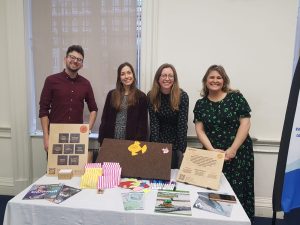
As well as musing on the importance of communication, and learning a huge amount about spatial squeeze, ocean literacy and fisheries management plans, we were thrilled to be able to play a central role in Coastal Future’s return, both as sponsors of the event and by providing tailored event support.
Over at our stall, which we doused in sweets and colourful fish post-it notes, our friendly team were forging new connections, talking to attendees about their projects and giving advice about how to effectively communicate their research or initiatives.
The 30th Coastal Futures was significant as the first to be organised by the new Ocean & Coastal Futures collaboration. Mindfully Wired’s Events team stepped in to provide technical support and advice to make sure the conference went off without a hitch.
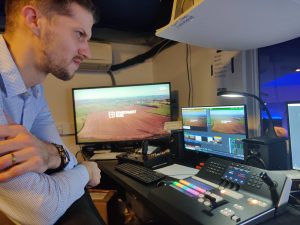
Events Manager Paul Botterill said: “It was a real honour to be asked to support what can only be described as the Glastonbury of ocean conservation conferences. This year’s Coastal Futures took place for the first time ever as a hybrid event, with 400 joining us in-person at the Royal Geographical Society and a further 300 engaging online.”
“While hybrid events can present challenges, the result is a conference that is more inclusive, with global online audiences able to join in the discussions and connect with those in the room.”
Our ears were left burning after some shoutouts during the presentations. Katie-Jo Luxton, Director of Global Conservation at RSPB used infographics in her presentation on nature positive offshore wind infrastructure that drew from design work that we did on their Powering Healthy Seas report (this also played no small part in them winning the unofficial MWC award for best presentation design).
George Clark, Programme Director at MSC similarly referenced MWC design work on Project UK, including report design and building their website. Jon Davies from Defra spoke about our work on Future of Our Inshore Fisheries with Seafish. And Dr. James Grellier showcased the Blue Health toolbox which we copy-edited during his presentation on how access to blue space is an important factor in wellbeing.
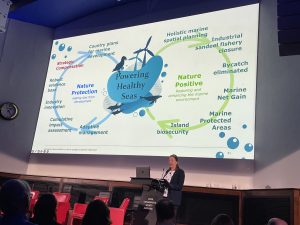
Rounding up the fun!
As the conference came to a close, we reflected on the thousands of conversations that must have taken place in the labyrinth-like corridors of the Royal Geographical Society over hundreds of cups of tea and coffee, where the seeds of potentially game-changing ideas and new partnerships were planted. We were left inspired by scientists sharing their research, and raring for action after speakers from all generations, cutting across multiple disciplines, reiterated to us what’s at stake if we fail to act.
But to take us back to Aisling’s point on the first morning of Coastal Futures: while it’s true we should take a few risks and push ahead with action to protect our seas and coasts, we must not underestimate the role of effective communications in getting the buy-in from across society to ramp up efforts. This is also important because sometimes, the answers to the challenges we face are not always clear-cut. Only by creating inclusive channels to communicate can we craft a truly coordinated approach going forwards.
